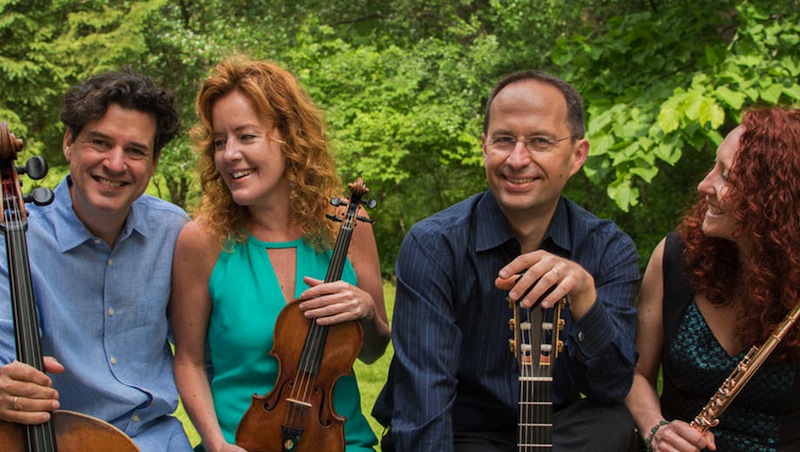Fandango! serves up a wide array of national musics with flair
Fandango! is an exciting and refreshing ensemble based in Chicago comprised of flutist Eugenia Moliner, violinist Desirée Ruhstrat, guitarist Denis Azabagic, and cellist David Cunliffe.
This unusual group of musicians from four countries—Spain, Bosnia and Herzegovina, UK, and USA—play to their strengths with authentic repertoire choices, exciting arrangements, and newly commissioned works.
Sunday afternoon at Barry University’s Broad Performing Arts Center in Miami Shores, Fandango! played for the Saint Martha Concerts in front of a nearly sold-out audience.
Framing the program were the ensemble’s arrangements of Vivaldi’s “Winter” from The Four Seasons and the Grave assai-Fandango from Boccherini’s Quintet in D Major for Guitar and Strings.
In the Vivaldi, violinist Ruhstrat thrived in the expressive cantilenas and the boisterous passages, although her bow control in the spiccato sections lacked something in bounce. A sparse, delicately played trio texture in the last movement preceded the hurling cascade of unison between violin and flute, which was perfectly matched leading to the end of an iconic piece.
The arrangement of Boccherini’s quintet displayed qualities of cohesive phrasing and articulation. The castanets towards the end of the movement and the prominence of the guitar provided a Spanish flair fitting to the title and character of the composition.
Besides certain balance issues, perhaps caused by less-than-artful amplification, the ensemble displayed good control of dynamics and projection of musical subtleties.
The remainder of the program explored various combinations within the group.
Trio Sefardi by Alan Thomas and Plegaria y Kanto by Carlos Rafael Rivera exposed the nostalgia, sorrow, and hope that characterizes music from the folkloric tradition of the Sephardic Jews. In both compositions, guitarist Azabagic displayed a high level of musicianship and technical prowess in the improvisational and polyphonic sections. Compound rhythms, intricate phrasing, and exotic modal melodies posed no technical challenges for the ensemble, who all played with ease and astute musicianship.
Thomas was the composer as well for the Fantasy on Themes from “La Traviata” for flute and guitar—a concoction of astonishing virtuosity, sprawling phrases, and assertive musical personality. Flutist Moliner shone like a prima donna in this demanding arrangement. She skated effortlessly through the coloratura cadenzas, captured the coquettish charm of Violetta, and produced some of the most gorgeous sounds of the evening with her lengthy soaring high notes. Azabagic’s eloquent, yet emphatic playing, and Moliner’s brilliant execution made for a captivating performance.
The most toe-tapping work of the evening was Three Balkan Pieces by Macedonian composer Miroslav Tadic. Each movement showcased distinct Balkan idioms. “Pajdushka” was an uplifting dance in 5/8 meter often performed in folkloric festivals, while “Zajdi, Zajdi” – a story about a shepherdess singing to the sun– lamented the passing of youth. The music evokes imagery of vast valleys, and echoes of voice and wind enwtined in the beautiful conversational exchange between flute and cello, as Cunliffe delved into a warm expressive vibrato.
“Gajdarsko Oro,” loosely translated as a “bagpipe circle dance,” embodied the bold and effervescent quality of the Balkan peoples. While the last phrase could have propelled forth with more stamina, this performance undoubtedly showed Fandango!’s variety of articulations, colors, and panache.
Posted in Performances
Leave a Comment
Mon Feb 27, 2017
at 12:22 pm
No Comments







